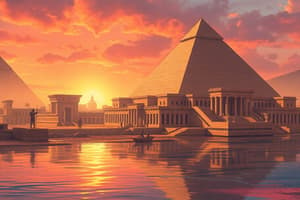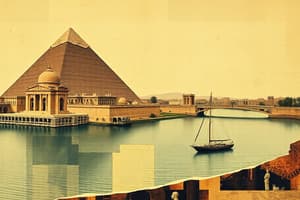Podcast
Questions and Answers
What geographical features protected ancient Egypt from invaders?
What geographical features protected ancient Egypt from invaders?
The Red Sea to the east and the Sahara Desert to the west protected ancient Egypt from invaders.
Why is the Nile referred to as 'the gift of the Nile'?
Why is the Nile referred to as 'the gift of the Nile'?
The Nile is called 'the gift of the Nile' because its flooding annually provided fertile soil for agriculture.
Who is credited with uniting Upper Egypt and Lower Egypt?
Who is credited with uniting Upper Egypt and Lower Egypt?
King Menes is credited with uniting Upper Egypt and Lower Egypt around 3200 BCE.
Describe the social hierarchy in ancient Egypt.
Describe the social hierarchy in ancient Egypt.
What were the primary materials used for building houses in ancient Egypt?
What were the primary materials used for building houses in ancient Egypt?
What staple foods formed the basis of the Egyptian diet?
What staple foods formed the basis of the Egyptian diet?
What role did inscriptions play in ancient Egyptian society?
What role did inscriptions play in ancient Egyptian society?
How did the presence of slaves impact the structure of Egyptian society?
How did the presence of slaves impact the structure of Egyptian society?
What does the term 'hieroglyphics' refer to in ancient Egyptian writing?
What does the term 'hieroglyphics' refer to in ancient Egyptian writing?
What materials did ancient Egyptians use for writing?
What materials did ancient Egyptians use for writing?
How did the Egyptians devise their solar calendar?
How did the Egyptians devise their solar calendar?
What was one of the major contributions to mathematics by the Egyptians?
What was one of the major contributions to mathematics by the Egyptians?
What role did astronomy play in ancient Egyptian agriculture?
What role did astronomy play in ancient Egyptian agriculture?
How did the Egyptians measure time during the day and night?
How did the Egyptians measure time during the day and night?
What medical practices were evident in ancient Egypt?
What medical practices were evident in ancient Egypt?
Identify a key factor that contributed to the decline of the Egyptian civilization.
Identify a key factor that contributed to the decline of the Egyptian civilization.
What was the status of Egypt after being absorbed into the Roman Empire?
What was the status of Egypt after being absorbed into the Roman Empire?
How did knowledge in various fields impact the achievements of ancient Egyptians?
How did knowledge in various fields impact the achievements of ancient Egyptians?
What major crop was linked to the agricultural economy of ancient Egypt?
What major crop was linked to the agricultural economy of ancient Egypt?
How did the Egyptians enhance their agricultural practices to manage flooding?
How did the Egyptians enhance their agricultural practices to manage flooding?
What materials did ancient Egyptians use for making their clothing?
What materials did ancient Egyptians use for making their clothing?
Which god was considered the creator of all things in ancient Egyptian religion?
Which god was considered the creator of all things in ancient Egyptian religion?
What was the purpose of embalming in ancient Egyptian burial practices?
What was the purpose of embalming in ancient Egyptian burial practices?
What is the significance of the pyramids in ancient Egyptian architecture?
What is the significance of the pyramids in ancient Egyptian architecture?
What types of animals were commonly domesticated by ancient Egyptians?
What types of animals were commonly domesticated by ancient Egyptians?
How did ancient Egyptians use boats in their transportation?
How did ancient Egyptians use boats in their transportation?
What role did metalwork play in ancient Egyptian craftsmanship?
What role did metalwork play in ancient Egyptian craftsmanship?
Which goddess was represented by a statue known as Mau in ancient Egyptian religion?
Which goddess was represented by a statue known as Mau in ancient Egyptian religion?
What was the main purpose of the tombs built for the pharaohs?
What was the main purpose of the tombs built for the pharaohs?
What advanced skills did ancient Egyptians demonstrate in their pyramid construction?
What advanced skills did ancient Egyptians demonstrate in their pyramid construction?
What cosmetic products were commonly used by ancient Egyptians?
What cosmetic products were commonly used by ancient Egyptians?
Which major trade routes did ancient Egyptians use for commerce?
Which major trade routes did ancient Egyptians use for commerce?
Flashcards are hidden until you start studying
Study Notes
Overview of Egyptian Civilization
- Egyptian civilization emerged over 4,000 years ago along the Nile River, with fertile land protected by the Red Sea and Sahara Desert, leading to 2,000 years of stability.
- Known as "the gift of the Nile" due to the river's annual floods that enriched the soil, facilitating agriculture.
Historical Foundations
- Two kingdoms, Upper and Lower Egypt, existed until around 3200 BCE when King Menes united them, marking the start of the civilization.
- The civilization ended with the death of Cleopatra in 30 BCE, ending the pharaonic era.
Social Structure
- Pharaohs were viewed as divine, with their words considered law; social hierarchy: nobles, priests, scribes, peasants, laborers, and slaves.
- Slavery involved captured individuals working as domestic laborers or in mines.
Architecture and Dwellings
- Early housing utilized papyrus and mud, later shifting to sun-dried mud bricks; common homes were one-story and flat-roofed.
- Wealthy citizens had larger homes with gardens and ponds.
Food and Clothing
- Diet centered on bread made from emmer and barley beer, supplemented by fish, meats, vegetables, fruits, and dairy.
- Clothing made from flax yielded fine linen; women wore gowns while men dressed in loincloths and tunics, accessorized with jewelry and wigs.
Occupations and Agriculture
- Agriculture, dependent on Nile floods for fertility, was the main occupation; farmers learned to build dams and canals for irrigation.
- Principal crops included barley, emmer, millet, and various fruits; oxen used for plowing.
Domestication and Crafts
- Commonly domesticated animals included cows, pigs, and geese, providing meat and labor.
- Artisans excelled in pottery, glass-making, and carpentry, producing intricately crafted furniture and vessels.
Metallurgy and Technology
- Metalworking knowledge was acquired from the Hyksos, leading to the crafting of fine metal objects, including Tutankhamun’s death mask.
Religious Beliefs
- Egyptians worshipped nature deities, with Ra (sun god) as the chief, alongside gods like Thoth, Horus, Isis, and Osiris.
- Temples were built in honor of these gods, with certain animals considered sacred.
Burial Practices
- Mummification reflected beliefs in the afterlife; bodies were preserved and buried with items for the next life.
- Grand tombs, such as the pyramids of Giza for pharaohs like Khufu, signified elite burials.
Transportation and Trade
- The Nile served as a trade route; Egyptians built boats and invented sails for effective transport and trade.
- Trade routes extended to the Red Sea and Mediterranean, exchanging goods like copper and olive oil for gold and linen.
Art, Architecture, and Writing
- Pyramids symbolize Egyptian architectural prowess and serve as historical evidence; the Sphinx is a notable sculpture.
- Hieroglyphics, composed of pictorial symbols, marked the writing system, with papyrus developed for documentation.
Scientific Achievements
- Egyptians developed a solar calendar of 365 days, leading to advancements in agriculture and seasonal predictability.
- Mathematics, astronomy, and medicine were highly developed; water clocks measured time accurately.
Decline of Civilization
- Pharaoh Ramesses II's military campaigns strained resources, leading to the rise of powerful high priests reducing the pharaoh's control.
- Successive invasions from Nubians, Assyrians, Persians, and Greeks weakened stability, culminating in Roman annexation in 30 BCE.
Studying That Suits You
Use AI to generate personalized quizzes and flashcards to suit your learning preferences.




